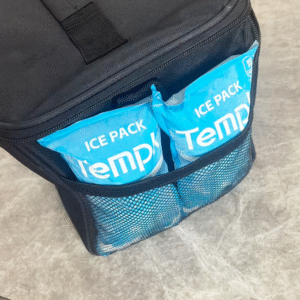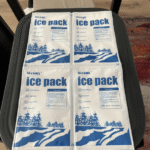À la recherche d'alternatives efficaces à la glace sèche pour l'expédition de produits sensibles à la température 2025? Que vous expédiiez de la nourriture, médicaments, ou d'autres marchandises périssables, Choisir le bon liquide de refroidissement est essentiel. Dans cet article, we’ll explore the best dry ice alternatives available for your business, y compris les packs de gel, Matériaux à changement de phase (PCMS), et des options écologiques qui garantissent une expédition sûre et efficace.
-
Que sont les best dry ice alternatives for shipping?
-
Comment les emballages sur gel, PCMS, et des options écologiques comparées à la glace sèche?
-
Quels produits et industries bénéficient le plus des alternatives de glace sèche?
-
Quels sont les avantages et les inconvénients de chaque alternative?
-
Comment choisir la meilleure alternative de glace sèche en fonction de vos besoins d'expédition?
Quelles sont les meilleures alternatives de glace sèche pour 2025?
Alternatives sur la glace sèche comme les packs de gel, Matériaux à changement de phase (PCMS), et les options écologiques offrent un contrôle stable de la température pendant le transit. Ces alternatives sont conçues pour diverses industries, offrir une flexibilité, solutions écologiques, et des options rentables pour assurer la sécurité des produits.
Here’s a breakdown of the top dry ice alternatives for 2025:
-
Packs de gel: Ideal for maintaining temperatures between 32°F and 60°F, gel packs are perfect for shipping refrigerated products.
-
Matériaux à changement de phase (PCMS): PCMs offer precision temperature control, making them ideal for sensitive items like pharmaceuticals that need to remain within a specific range.
-
Biodegradable Coolants: Eco-friendly alternatives that reduce environmental impact while still providing reliable temperature control.
Why Are Dry Ice Alternatives Important in 2025?
Dans 2025, regulations around environmental impact and shipping guidelines are tightening. Dry ice presents several issues, including safety hazards and the requirement for specialized handling. Alternatives, tels que les packs de gel et les PCM, are not only safer to handle but also more sustainable and cost-efficient. These alternatives help businesses comply with emerging environmental regulations and avoid the challenges of using dry ice.
Packs de gel: A Reliable Alternative for Temperature Control
Gel packs are one of the most commonly used alternatives to dry ice. These cooling packs are filled with a gel that retains cold for extended periods. They are widely used in industries like food and pharmaceuticals due to their versatility and ease of use.
How They Work
Gel packs absorb heat from the contents of the package, maintaining the desired temperature range for extended periods. They typically keep temperatures between 32°F and 60°F, which is perfect for refrigerated goods.
Why Use Gel Packs?
-
Rentable: Gel packs are more affordable than dry ice and easier to manage.
-
Plus sûr à gérer: Contrairement à la glace sèche, they do not pose safety risks and do not require special handling.
-
Réutilisable: Many gel packs are reusable, which makes them a more sustainable option for long-term use.
Pros and Cons of Gel Packs
| Pros | Inconvénients |
|---|---|
| Facile à manipuler | Limited temperature range (32°F to 60°F) |
| Abordable | Not ideal for extremely low temperatures |
| Réutilisable | May require extra insulation for long trips |
Matériaux à changement de phase (PCMS): Contrôle de la température de précision
Matériaux à changement de phase (PCMS) are gaining popularity due to their ability to maintain specific temperatures for extended periods. These materials absorb or release heat as they change between solid and liquid states.
How They Work
PCMs are designed to melt and freeze at a specific temperature. Par exemple, a PCM that melts at 4°C can maintain that temperature for hours, ensuring that temperature-sensitive products remain within the desired range.
Why Choose PCMs?
-
Précision: PCMs provide highly accurate temperature control compared to gel packs.
-
Personnalisable: They come in various temperature ranges, making them ideal for diverse shipping needs.
-
Écologique: Many PCMs are non-toxic and can be recycled or reused.
Pros and Cons of PCMs
| Pros | Inconvénients |
|---|---|
| Highly accurate temperature control | Can be more expensive |
| Ideal for sensitive products | Requires precise packaging |
| Écologique et non toxique | May require extra insulation |
Eco-Friendly Coolants: Sustainable Shipping Alternatives
Dans 2025, sustainability is at the forefront of the cold chain logistics industry. Eco-friendly coolants, such as biodegradable gel packs and recyclable options, offer a greener alternative to traditional cold packs. These alternatives help businesses reduce their environmental footprint.
Why Eco-Friendly Coolants Matter
-
Durabilité: Many eco-friendly coolants are biodegradable, reducing waste and environmental impact.
-
Less Environmental Damage: These coolants are often made from renewable resources, minimizing the use of non-renewable materials.
-
Green Certifications: Eco-friendly options are perfect for businesses looking to earn green certifications and appeal to environmentally conscious consumers.
Pros and Cons of Eco-Friendly Coolants
| Pros | Inconvénients |
|---|---|
| Biodegradable and recyclable | May be less effective than traditional gel packs |
| Respectueux de l'environnement | Could be more costly |
| Suitable for various temperature ranges | Less widely available compared to traditional options |
Which Industries Benefit Most from Dry Ice Alternatives?
Dry ice alternatives are essential in several industries, especially those requiring reliable temperature control during shipping.
Médicaments
Cold packs and PCMs are vital for maintaining the required temperatures for vaccines and biotech products, especially during long-distance transport.
Industrie alimentaire
Aliments périssables, including dairy, chocolat, et aliments surgelés, benefit greatly from dry ice alternatives. These coolants ensure quality preservation during transit.
Beauty and Cosmetics
High-end cosmetic products often require temperature control to maintain their quality and stability. Dry ice alternatives help preserve sensitive beauty items during shipping.
How to Choose the Best Dry Ice Alternative for Your Needs?
When selecting the right dry ice alternative, consider several factors:
-
Plage de température: Gel packs are best for chilled items, while PCMs offer precise control for a wider range of temperatures.
-
Durée d'expédition: Pour les expéditions plus longues, PCMs or biodegradable options may be ideal.
-
Considérations environnementales: If sustainability is a priority, opt for biodegradable or recyclable coolants.
-
Sensibilité au produit: Highly sensitive items like pharmaceuticals benefit from the precise control provided by PCMs.
What to Consider When Using Dry Ice Alternatives
Packaging and Insulation
Packaging plays a crucial role in ensuring the effectiveness of your dry ice alternative. Proper insulation is necessary to maintain the required temperature, especially during longer shipments.
Méthode d'expédition
Choosing the right carrier is also critical. Some shipping companies have specific guidelines for handling refrigerated shipments, so make sure your chosen carrier can accommodate your cold chain needs.
Trends in Cold Chain Shipping in 2025
Sustainable Cold Chain Practices
With increasing demand for eco-friendly solutions, more companies are turning to sustainable cold chain solutions in 2025. Green logistics and eco-conscious shipping practices will continue to gain momentum.
Surveillance de la température intelligente
Advancements in cold chain technologies, such as real-time temperature tracking, will allow businesses to monitor their shipments more effectively, ensuring products stay within the ideal temperature range.
Questions fréquemment posées
Q1: Are dry ice alternative packs as effective as dry ice for shipping frozen products?
Oui! Many dry ice alternatives, such as phase change materials and gel packs, provide excellent temperature control for frozen items. They are just as effective as dry ice while being safer and more cost-efficient.
Q2: Can I reuse dry ice alternative packs?
Oui, many dry ice alternatives, including gel packs and PCMs, sont réutilisables. They can be thawed, refrozen, and used multiple times, making them a more sustainable and economical choice for cold chain shipping.
Q3: Are there any safety concerns with dry ice alternatives?
Non. Dry ice alternatives are safer than traditional dry ice. They do not have the same risks, such as sublimation or extreme cold exposure, and do not require special handling precautions.
Conclusion et prochaines étapes
Dans 2025, dry ice alternatives like gel packs, PCMS, and eco-friendly coolants are not just viable options—they’re often the better choice for safe, durable, and cost-effective shipping solutions. Que vous expédiiez de la nourriture, médecine, ou cosmétiques, choosing the right coolant will ensure your products remain at the proper temperature.
Étapes suivantes:
-
Évaluez vos besoins d’expédition (plage de température, durée).
-
Choose the best dry ice alternative (packs de gel, PCMS, eco-friendly options).
-
Ensure compliance with shipping carrier guidelines for temperature-sensitive goods.
-
Optimize packaging for temperature control throughout transit.
À propos du tempk
Tempk is a cold chain packaging company specializing in safe and sustainable shipping solutions. Nos produits, including eco-friendly coolants, packs de gel, and PCMs, are designed to help businesses maintain product quality while reducing environmental impact. Trust Tempk for reliable, conforme, and eco-conscious cold chain solutions.
Prêt à rationaliser votre logistique de la chaîne du froid? Contact Tempk today for expert advice on temperature-sensitive shipping.
























